
In the U.S.today, nearly 1.9 million GPS/wireless devices are used to monitor fleet vehicles, trailers, construction equipment and mobile workers.These GPS-based Mobile Resource Management (MRM) applications currently account for nearly $1 billion in annual revenue for wireless network operators and suppliers of MRM applications and equipment.By 2009, the number of MRM units in service is expected to grow to 5.8 million, while annual revenues increase to nearly $2 billion.
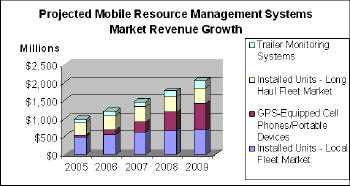 |
U.S.Fleets Continue to Install GPS Tracking Systems
As shown in the chart below, the largest MRM market segments in the U.S.today are the local and long haul fleet Automatic Vehicle Location (AVL) markets, which use installed GPS/wireless devices to track the location of fleet vehicles.While the number of U.S.fleet vehicles equipped with AVL systems has grown to over 1.3 million, total market penetration remains under 10%.
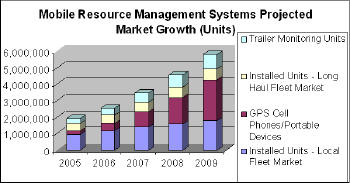 |
The long haul AVL market, which is more mature than the local fleet AVL market, has experienced slower growth in recent years.However, it is still a large market that generates annual revenues of over $350 million.Despite slow overall growth in this segment, a few AVL suppliers to the trucking segment, including PeopleNet Communications and XATA, are experiencing strong growth.Some additional growth in this segment should be stimulated by the recent introduction, by several OEM truck manufacturers, of new telematics systems that include GPS tracking.Also, QUALCOMM, the market leader, announced plans to roll-out its new OmniVision fleet management system within the next year.
GPS-equipped Cell Phone Tracking Market Rapidly Expanding
One of the fastest growing MRM market segments today is the emerging market for managing mobile workers through the use of GPS-equipped cellular phones and other portable devices.The C.J.Driscoll & Associates' Commercial Telematics Systems and Services Study, released in October 2003, reported that at the time of the study, two-thirds of local fleet operators used cellular phones to communicate with drivers. Today, the percentage of fleet drivers and other mobile workers using cellular phones, Blackberrys or other portable wireless devices is even higher.For fleets and enterprises whose mobile workers already use cellular phones, converting to GPS-equipped units is a relatively simple transition, requiring little investment.
In addition to quantifying the use of cell phones in local fleet operations, the Commercial Telematics Systems and Services Study also provided an early glimpse at interest of fleet operators in using GPS-enabled cellular phones to monitor the location of fleet vehicles and drivers.The 400 fleet managers participating in the study were asked if they intended to purchase either an installed vehicle tracking system or GPS-capable cellular phones for drivers in the next 12-18 months.As shown in the following chart, nearly one-third of the surveyed fleet operators (31%) reported that they expected to purchase either installed or handset-based tracking devices within the next 18 months, and nearly two-thirds of these respondents expected to purchase GPS-capable cellular phones.
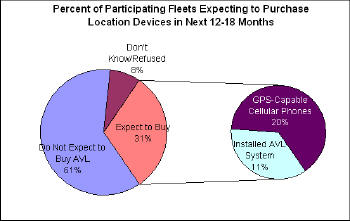 |
As shown in the MRM Revenue chart, the market for managing mobile workers through the use of GPS-equipped cellular phones and other portable devices is projected to account for over one-third of total MRM market revenues by 2009.It is estimated that by the end of 2009, over two million cellular phones and handheld computers will be used for mobile workforce management applications.GPS will become a standard feature of many field force automation and transportation/logistics applications used by large enterprise customers, resulting in improved time and task management, dispatching efficiency, route optimization, customer service and other benefits.
Trailer and Heavy Equipment Monitoring
With a current installed base of more than 250,000 units, the trailer monitoring systems market has doubled in size over the last two years. With more than five million commercial trailers in operation in the U.S., current market penetration is only about 5%, and this market is expected to continue to grow significantly over the next several years.
In October 2004, C.J.Driscoll & Associates released the Trailer Monitoring Systems and Services Study, which was sponsored by the leading U.S.suppliers of trailer monitoring systems and services.This study confirmed U.S.trucking fleet operator interest and willingness to pay for trailer monitoring systems.As shown in the following chart, of the 168 trucking fleet managers surveyed, 60% indicated a willingness to invest in trailer monitoring equipment and 70% would pay a recurring monthly fee to monitor their fleet trailers.The study analyzes the amount trucking fleet operators are willing to pay for trailer monitoring systems and services, which varies based on factors such as the nature of the company's operations and the size of the fleet.
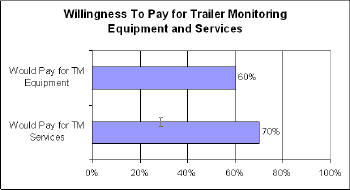 |
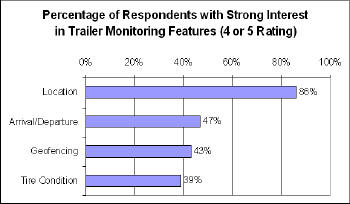 |
The largest U.S.supplier of Mobile Resource Management Systems is QUALCOMM, which provides tracking and wireless data communications service for an estimated 417,500 mobile units.Nearly three-fourths of QUALCOMM's MRM installed base is equipped with the company's OmniTRACS fleet management system, which is widely used in the long haul trucking industry.However, QUALCOMM is also a leading supplier of trailer monitoring systems and systems for monitoring the location and status and heavy equipment.
In the trucking sector, PeopleNet Communications is another major MRM supplier that has grown significantly in recent years.Since early 2003, the company's installed base has more than doubled, from an estimated 25,000 units to 55,000 units.
In the local fleet market, Teletrac has expanded its subscriber base to more than 45,000 units, and is contributing 50% or more of parent company TrafficMaster's revenues and profits.The company is reported to be adding to its sales and marketing staff in hopes of further increasing its market penetration.
With an installed base of more than 40,000 units, Xora is among the largest suppliers of cell phone based tracking systems.As a Nextel partner, Xora's application is sold and invoiced by Nextel, and has contributed significantly to the company's growth.
In the trailer monitoring sector, SkyBitz is one of the fastest growing suppliers.The company's installed base has grown from an estimated 5,000 units in early 2003 to more than 60,000 units today.
FleetMatics is a European MRM supplier that has recently entered the U.S.market.The company has established offices in Boston, New York and Chicago, and plans to open additional offices in the future.
The 2005-06 Mobile Resource Management Systems Market Study includes a table listing the largest U.S.Mobile Resource Management System suppliers, and also shows each supplier's subscriber growth since early 2003.The report provides profiles of over 160 suppliers of Mobile Resource Management systems and services, including target markets, unique features, installed base and system pricing.